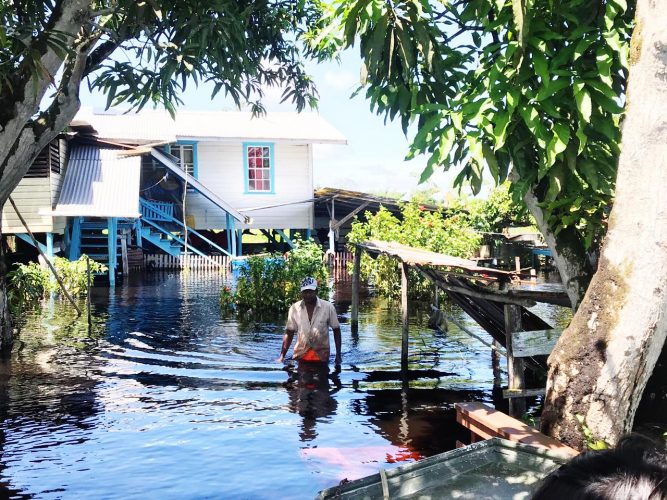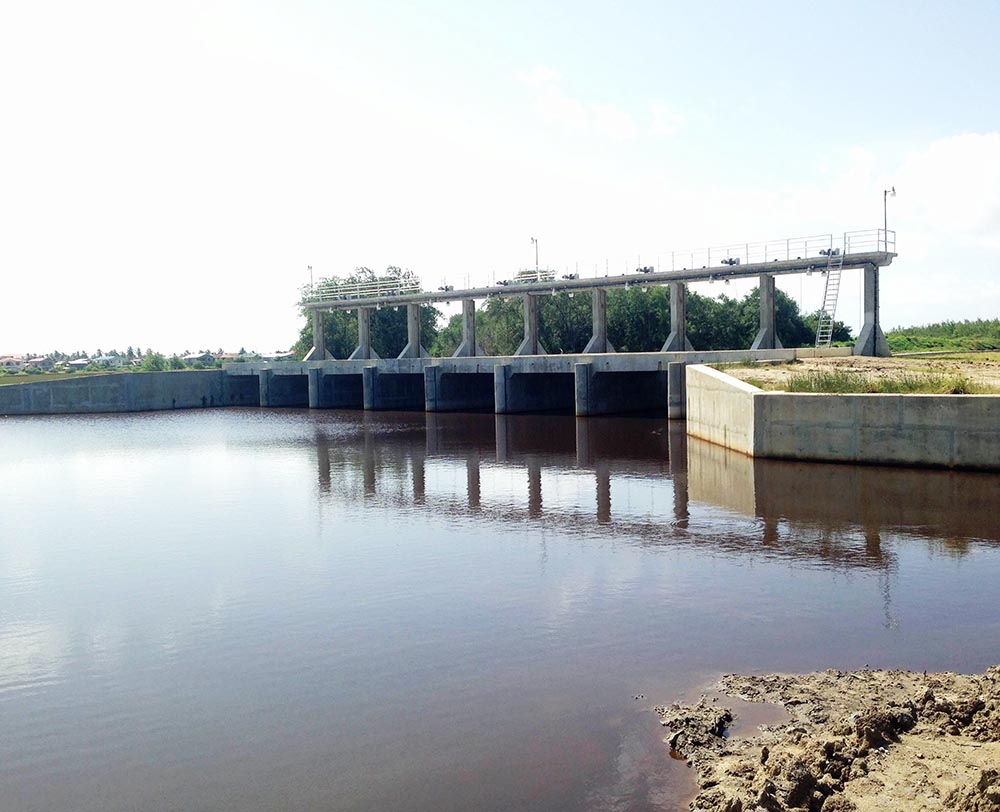In response to two catastrophic floods in 18 years, Guyana is stepping up the protection of its vulnerable coastline, using funds from its recent carbon credits’ sale to finance the construction of multiple door sluices and other water management initiatives.
At the top of the country’s plan, is the replication of the Hope Canal eight-door sluice, which was built to prevent the recurrence of the catastrophic 2005 Great Flood. The multi-door sluice has the capacity to drain water at 58 cubic metres per second and will be replicated in regions Two, Three, Five and Six. The plan is part of a broader flood mitigation and climate adaptation approach by the government.

Guyana has earned US$75 million from the historic carbon offsets’ sale to Hess Corporation. As a significant emitter, Hess will make payments for carbon emissions, which will be used to improve community well-being by supporting sustainable projects and infrastructure, thereby advancing the cause of climate justice.
Of the US$75 million, 15 percent went to indigenous communities and the remainder, Vice President Bharrat Jagdeo said, will support the country’s climate adaptation measures.
“Climate adaptation is big for Guyana, not just flood control and water management, that is water from the sea, excessive rainfall putting in the infrastructures to manage the impacts, but also potable water from saline intrusion and a whole range of other issues,” he explained at press engagement last week.
The use of funds from carbon credit sales to finance these projects is an illustration that Guyana is taking a sustainable approach to address the challenge of climate change and its impact on the environment, some observers have said.
“We can’t wait for climate funds or adaptation funds to come through the global mechanism. Most countries in the region are waiting, we can’t wait,” Jagdeo said at the recently concluded International Energy Expo, held at the Guyana Marriott in February. He said some US$2 billion is required to beef up protection for the country’s at-risk coastline. Approxi-mately 80 percent of the population reside on the coastal plan, which is also home to the country’s agricultural production.
Jagdeo explained further that with financing from the fund, the government was also looking at mechanisms that can support water management and navigation for agricultural production.
He said the government is working on an integrated water resources management plan.
“So this will support projects along that line… It may go into other areas but it will allow us as a country to better prepare for climate change,” he added.
He stated that the new drainage structures will allow for drainage even during the high tide period making it possible for faster drainage.
The projects are currently being finalised and will soon be advertised to the public for tenders.
Following the 2021 floods, which left a trail of devastation and collectively were deemed worse than 2005 in some quarters, the government undertook studies to replicate the multi-component channel and sluice. The Hope Canal or Northern Relief Channel, which is located at Hope/Dochfour, East Coast Demerara was constructed at a cost of $3.6 billion and was credited for the prevention of excessive flooding in Georgetown and along the East Coast in 2021.
The Civil Defence Commis-sion estimated that the flood in June 2021, affected some 36,000 households, while in December close to 6,000 homes were impacted. In some areas inland, water levels climbed to over 14 feet high. Farmers of both crops and livestock suffered losses.
The sale of carbon credits, which is a non-traditional revenue earner, will allow the country to support climate mitigation without being reliant on funding from the national budget, Jagdeo explained.
In addition to financing the replication of the Hope Canal-like structures, he said the government was also looking to fund sea defences and work to strengthen the conservancy earthen dam.
“We have a massive stretch of vulnerable coastline that is about three kilometres in Region Five (Mahaica/Mahaicony) that is in a bad shape… It is really really tough there in Berbice… We have a cycle of erosion and I think they are facing the brunt of the erosion cycle…,” Jagdeo explained, noting that the repairs will cost a significant sum of money.
During 2018 and 2020, farmers suffered millions in losses as they were unable to reap rice. A breach in the sea defence, which at the time was an earthen dam at Mahaicony, had caught farmers by surprise. Since then they have not been able to return to the land, which had been inundated by saltwater, to cultivate rice.
The shoreline has been subjected to an extreme, cyclic foreshore erosion. As a result of powerful waves during the erosion cycle, mud banks that once held mangroves in position, which served as a buffer, were washed away. This resulted in a complete depletion of mangroves from the battered shoreline. The government was forced to execute 2,260 metres of permanent revetment as emergency work.
Former minister of public infrastructure David Patterson, during a 2019 engagement at the University of Guyana for the 21st instalment of its Turkeyen and Tain Talks “Green Building for Resilient Future Cities,” said that $14 billion was needed between 2020 and 2022 to effect “urgent” repairs to 32.9 kilometres of sea defence. He had explained that if the government failed to execute that work, communities across the coast would suffer a fate similar to that of Mahaicony.
Meanwhile, some of the carbon credit funds are earmarked for strengthening the conservancy water dam, which is crucial in the catchment of excess water.
However, before the funds can be used to support these measures, Vice President Jagdeo explained, Finance Minister Ashni Singh will have to go to the National Assembly and request a supplementary allocation. The remaining sum will be moved from the US dollar-denominated account held by the Bank of Guyana overseas, to the Consolidated Fund, which will be credited with the Guyana dollar equivalent.
In accordance with the established budgetary process enshrined in law, the Minister of Finance shall request the National Assembly to approve withdrawals from the Consolidated Fund, which shall be included in the Annual Budget Proposal. All of these transactions will be appropriately tagged with a unique identifier on the Integrated Financial Management Information System in the Ministry of Finance to enable the execution of annual audits.
On December 2, 2022, the Government of Guyana entered into an agreement with Hess Corporation for the sale of carbon credits for a minimum of US$750 million between 2022 and 2032. The deposit of US$75 million as first payment represents US$37.5 million for 2.5 million ART-TREES credits from 2016 at a price of US$15/tonne of carbon dioxide equivalent (CO2e); and US$37.5 million for 2.5 million ART-TREES credits from 2017 at a price of US$15/tonne of CO2e.






